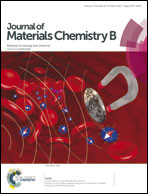Pulsatile drug release from electrospun poly(ethylene oxide)–sodium alginate blend nanofibres†
Abstract
Novel and highly tuneable pulsatile drug delivery systems have been prepared through the electrospinning of a blend of poly(ethylene oxide) (PEO), sodium alginate (SA), and sodium ibuprofen (SI). The resultant fibres contain crystallites of SI embedded in a PEO–SA matrix, and rather than being obtained as flat mats on the collector plate form novel three dimensional structures extending upwards the needle. Fibres were prepared with a range of loadings of SI and SA. It was found that at pH 6.8 (reminiscent of the intestinal tract) the fibres dissolve very rapidly, freeing all the embedded drug within ca. 20 minutes. However, at pH 3 (representative of the stomach pH in the fed state or in older patients) an unusual two stage release mechanism is seen. This comprises a rapid burst release, followed by a period where no further drug is released for ca. 120–150 minutes, and then a final stage of release freeing the remainder of the drug into solution. The amount of release in the initial stage, and the length of time between the first and final drug release stages, can be controlled by adjusting the SI and SA contents of the fibres respectively. This results in highly tunable pulsatile release materials.


 Please wait while we load your content...
Please wait while we load your content...